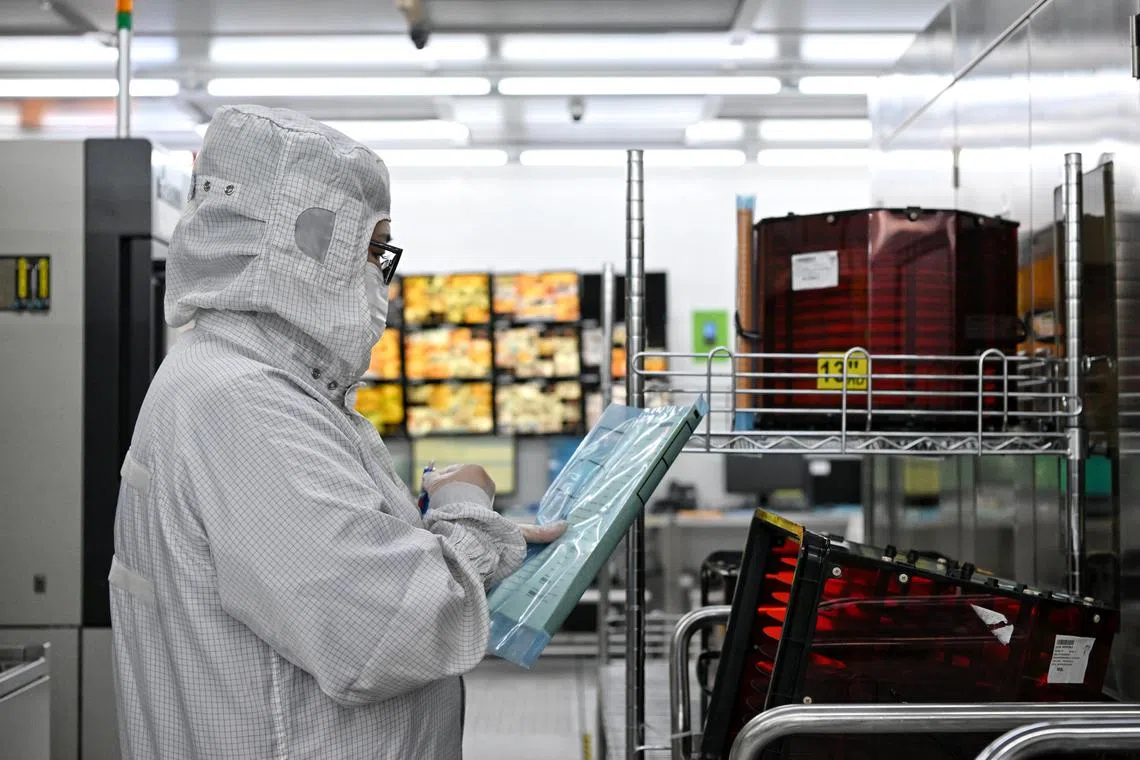Singapore manufacturing output beats forecast with 7.1% rise in July
Sign up now: Get ST's newsletters delivered to your inbox

The key electronics industry, which accounts for more than a third of total output, saw production expand 13.1 per cent.
PHOTO: ST FILE
Follow topic:
SINGAPORE – Singapore’s manufacturing output rose for the 13th straight month in July at a rate that surprised economists who were expecting anaemic growth.
Total output increased 7.1 per cent year on year, according to data released by the Economic Development Board on Aug 26. This easily beats the 0.9 per cent growth forecast by analysts in a Bloomberg poll.
Excluding the more volatile biomedical industry, production rose by an even larger 9.4 per cent.
On a seasonally adjusted month-on-month basis, manufacturing output in July grew 8.2 per cent. Excluding biomedical manufacturing, it expanded 7.1 per cent.
Year on year, five of the six industry clusters saw output grow in July.
The key electronics industry, which accounts for more than a third of total output, saw big gains, with production expanding 13.1 per cent.
Semiconductor output rose 9.6 per cent, while other electronic modules and components segments expanded 1.9 per cent. The infocomm and consumer electronics segment saw an 86.8 per cent increase in output, thanks to higher demand for server-related products.
The related precision engineering industry saw output increase 9.6 per cent.
Demand for chipmaking equipment led to an 11.7 per cent expansion for the machinery and systems segment, while the precision modules and components segment rose 0.9 per cent, with higher output of plastic precision components and electronic connectors.
Conversely, the computer peripherals and data storage segment contracted 4.2 per cent.
Maybank economist Brian Lee said Singapore’s electronics industry – which accounts for 37.4 per cent of manufacturing output – remains a bright spot as it benefits from the artificial intelligence and data centre boom.
Biomedical manufacturing output rose 0.2 per cent. The medical technology segment grew 3.3 per cent on the back of sustained export demand for medical devices. The pharmaceuticals segment increased 2.7 per cent due to higher production of biological products.
The transport engineering industry saw the biggest growth in output of 15.8 per cent.
Its biggest contributor was aerospace, where output rose 22.7 per cent, bolstered by higher production of aircraft parts and sustained maintenance, repair and overhaul jobs from commercial airlines.
The marine and offshore engineering segment grew 11.7 per cent, driven by increased activity in shipyards.
However, the land segment contracted 23.2 per cent.
Chemicals output increased 4.2 per cent. The specialities segment grew 10.4 per cent on the back of higher production of mineral oil additives and biofuels. Higher output of fragrances helped the other chemicals segment expand 9 per cent. Conversely, the petrochemicals segment declined 1.3 per cent.
Mr Chua Han Teng, a senior economist at DBS Bank, said that despite factory output outperforming in July, the bank remains cautious on the sector’s performance for the rest of the year due to the ongoing unpredictability of US tariffs.
“Singapore’s external demand would likely soften due to the drag from tariffs globally, and a payback from earlier export front-loading would also weigh on manufacturing momentum.”
UOB senior economist Alvin Liew said that because of export front-loading, trade-related services, such as wholesale trade, transport and storage, are likely to be hit harder than the manufacturing sector.
Singapore’s non-oil domestic exports dropped 4.6 per cent in July from a year ago, reversing from a rebound in June.
The July data from Enterprise Singapore shows that payback from the front-loading of orders to get ahead of higher US tariffs has started to hit Singapore’s trade figures, according to economists.
Key exports to the US, Singapore’s single largest export market, plunged 42.7 per cent in July.
Maybank’s Mr Lee said Singapore could benefit from diversion in export orders as its reciprocal tariff rate remains unchanged at 10 per cent – the lowest in Asia.
“In addition, many US trading partners in Asean, Japan and Korea have secured relatively lower tariffs, supporting regional trade volumes. This should limit the severity of any export slowdown in the second half.”
DBS’ Mr Chua added that Singapore’s electronics and biomedical manufacturers could face more uncertainties and threats from US sectoral tariffs on semiconductors and pharmaceutical products, unless there are specific exemptions or a longer implementation timeline.
General manufacturing output dropped 9.7 per cent in July, compared with a year ago, dragged down by most of the segments.
The miscellaneous industries segment contracted 8.2 per cent due to lower output of structural metal products, batteries as well as paper and paperboard containers and boxes.
The food, beverages and tobacco segment declined 11.3 per cent, led by lower production of beverages and bakery products, while the printing segment fell 2.4 per cent.


